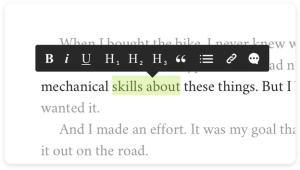Riley Adams's Blog, page 107
February 25, 2016
7 Author-Friendly Changes Bowker Could Make
By Elizabeth S. Craig, @elizabethscraig
The subject of ISBNs tends to make authors anxious. Sometimes writers are defensive about why they choose not to use them or choose to use the free ISBNs offered by CreateSpace and other retailers/distributors.
This isn’t a post debating the merit of ISBNs, although I do choose to use them myself. Briefly, there are a few reasons for my choice. One, I’m just old school. Another, as a self-publisher, I like the idea of my sales being counted (just as my trad-published sales are counted). For another, I like having my name listed as the publisher on record…not Smashwords or CreateSpace (nothing wrong with either of those guys and I use them both–just not their ISBNs). Most recently, my publishing through IngramSpark has required me to use a personal ISBN, so it worked out well that I already have them.
That being said! Bowker (the US agency that assigns ISBNs) annoys the dickens out of me. Here are some ways I believe the service could improve at Bowker. Or, let’s call it 7 ways for Me to Love Bowker Better:
Any list of improvements has got to have pricing at the top of the list. One ISBN is $125 (clearly, this is not the option to go with), 10 are $295, and 100 are $575. I do tend to buy them on sale and write them off as a business cost. But it’s a high price for what we’re getting. Especially if you consider the fact that each individual format does require a separate ISBN (an epub, a Kindle/mobi file, a print edition, etc.) They’re used up fairly quickly.
BISAC. Metadata is so important. But currently, my choices with BISAC categories on Bowker are limited. With most sites, I can drill down in the categories until I’m at FICTION / Mystery & Detective / Women Sleuths or FICTION / Mystery & Detective / Cozy. At Bowker, I can only get to Book – FICTION_MYSTERY and DETECTIVE_GENERAL. A metadata tip—anything with general in the category isn’t as helpful. More specific BISAC would help me more than many of the current metadata fields Bowker has (weight, weight units, carton quality, etc.).

It would sure make it a lot easier if English were listed at the top of the drop-down menu. It’s pretty time-consuming to get English to even pull up as the language. Lots of scrolling. Just…considering this is a US-based service. Nothing against all the other languages. IngramSpark, for example, makes this process easier by having “Common” at the top of the list (including English, Spanish, etc.) before continuing an alphabetical drop-down list.

Since most people choosing the $295 option or even the $575 option are self-publishers…why not just go ahead and make us our own separate portal to your site? Having to input my bio each time (and for each of the 3-4 formats!) is a time suck. I understand the service is also set up for publishers who order many thousands of ISBNs…but for those of us who are shelling out a good chunk of change to use this agency? I think having better default options with my login would be a perk.
How about a downloadable spreadsheet so I could track my orders/purchases. When tax time came, I had to call your customer service number to see how much money I spent with you in 2015. I was stunned this information wasn’t available under ‘My Account.’
While we’re at it (regarding a downloadable spreadsheet), how about one where I could track my formats and ISBN assignments? Formats are very important and that’s not reflected on the site. On the main page of my ‘manage ISBNs’ page, they’re all listed as electronic book text if they’re not print books. But we have to purchase/use separate ISBNs for epub and mobi files. Why make me open each entry to find out which is an epub ISBN and which is a mobi?
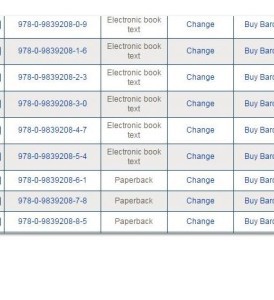
To make me feel better about these purchases (and to follow your sales better, and…heck, even maybe purchase more ISBNs) how about a subscriber newsletter with tips and sale notifications? A blog? Something that shows Bowker is attempting to give more value for an author’s investment.
Making these changes, many of them minor tweaks, would make me feel less of a chump for going through this cumbersome, expensive process.
Do you use ISBNs? Any other suggestions for Bowker?
7 author-friendly changes ISBN agency, Bowker, could make:
Click To Tweet
The post 7 Author-Friendly Changes Bowker Could Make appeared first on Elizabeth Spann Craig.
February 21, 2016
3 Reasons Your Writing Routine Will Land You On the Floor
by Colleen M. Story, @colleen_m_story
I was working too many hours a day. I knew it, but I had deadlines to meet. As a full-time freelance writer, it’s not like I could tell my clients I was getting too tired.
I kept going. Thirty-something years old, I wasn’t even thinking about my body. Sure, my back was a little sore when I finally shut the computer down for the night, but no pain, no gain, right?
I operated like this for months. Long hours. I still exercised—jogged several times a week and did about 30 minutes of yoga every night. I met my deadlines. But one weekend, while cleaning house, I leaned down to pick something up and lightning hit my spine.
I dropped to the floor. I’d never felt anything so painful. After getting over the shock, I tried to get up. The lightning came back. I waited a little while longer, and tried again. More lightning. Fire in my lower spine. I couldn’t move without reigniting it.
I got a little frightened. I worried something really serious had happened. But I can be patient. I waited. About an hour later, I was able to get up on my hands and knees. I could crawl around, as long as I was careful not to twist too much.
I slept on my side with a pillow between my knees. The next day, I could stand up, but I couldn’t lean over, not even slightly, without re-experiencing the horrible pain. I learned to walk like a robot, dreading any slight movement that would take me off-center.
A doctor’s appointment revealed I had herniated a disc. I was referred to a spinal specialist. Meanwhile, I returned to my yoga. I did slow, easy stretches every night. By the time I got in to see the spinal doctor a few weeks later, I had a nice lump in my back—which I still carry today—but I could touch my toes. I wouldn’t need surgery, thank heavens.
For the next two months, however, I had to do my work on the floor, with a notebook computer balanced on my belly.
I couldn’t sit, not even for 10 minutes, without suffering serious pain.
I vowed I would never let that happen again.
Today, I take regular precautions to make sure that yes, I meet my deadlines, but that also ensure I can keep meeting them without having to work on the floor.
If you’re a writer, and you spend more than an hour a day working at a computer, you’re at risk for back pain. Here are three signs that signal danger down the road—and accompanying action steps to be sure you don’t end up like I did!
1. You have back pain for more than a week.
May seem obvious, but ask yourself—how many times have you ignored those little aches and pains? I had quite a bit of “warning pain” before I ended up on the floor, but I ignored it, figuring it was just a sign of working long hours and I would be fine.
I’m not saying you have to run to the doctor if your back muscles are sore. In many cases, surgery, especially, doesn’t help.
“Studies that have randomized individuals with back pain to get either surgery or non-surgical treatments,” says Dr. Howard Schubiner, clinical professor at Wayne State University School of Medicine, “show little benefit to surgery.”
Instead, if you’re experiencing back pain, take it as a warning that you need to make some changes. We’ll talk about several of those, but let’s start with the most important one.
Action step: Cut back on the hours you’re spending in the chair. Sitting is the new smoking, they say. Studies have found it’s bad for you, on a number of levels. (Find more on that here—one study, for instance, found that sitting for more than 6 hours a day increased risk of death by nearly 40%.) In addition to affecting your overall health, it’s also horrible for your back.
When you sit, the top of the pelvis rotates backwards, which flattens the natural curve of the spine, creating more pressure on the discs. The best solution—get up and walk around. Every hour, take 5-10 minutes to walk. Set a timer. It’s that important.
2. You’re suffering from sciatica.
Maybe you’ve had it before, that shooting pain down the back of your leg. Sometimes we get it after a long road trip, or airline flight. Women may suffer from it during pregnancy. But if you’re experiencing it and you haven’t been traveling and you’re not pregnant, it’s time to pay attention.
Sciatica is a pain in the backside or a burning, tingling feeling down the back of the leg. You may also have weakness or numbness in the foot, and the pain may feel worse when you’re sitting. Usually the condition affects just one side.
Irritated nerves in the lower back cause the problem. It could also be a herniated disc. Like lower back pain, this is a sign that something isn’t right, and you need to make some changes.
Action step: Stretch.
Sitting tightens and shortens your hamstring muscles, which puts more pressure on your spine. Regularly stretching those muscles and the muscles in your lower back helps keep you flexible and pain-free.
I swear by yoga for back health. It’s the reason why I was able to recover on my own, without medical intervention. It also helps reverse muscle tension, and increases your endurance for working at the computer.
If you’re not into yoga, though, there are some stretches you can do to help reduce the pain of sciatica—and to prevent any future back problems. I’d highly recommend you get into a regular stretching routine that you do every day, no exceptions.
Here are some options to get you started:
Lie on your back. Pull one knee up into your chest. Grab the back of the leg and pull it closer to your chest. Hold for 20 seconds and release. Repeat on the other side, and repeat both 2-3 times.
In the same position, bring the knee up, and then, while keeping your back flat on the floor, take the opposing hand and place it on your raised knee. Slowly, pull that knee straight across your body toward the floor. You should feel the stretch in the lower back. Hold for 20 seconds and repeat on the other side.
Sit up straight with your legs extended straight out. Keeping your back straight, reach your hands toward your toes. Bending from the waist, lean forward as far as you can until you feel the stretch in the hamstrings. Hold for 20 seconds, release, and repeat.
Lie on your back with your knees bent, feet flat on the floor. Cross your right ankle over your left knee. Grasp behind your left knee and pull your legs toward your chest. Take care to keep the right knee away from the chest. Hold for 20-30 seconds, release, and repeat on both sides.
Try the pigeon pose. This one is great for opening up your hips and stretching your backside. It can be hard on your knees if you do it wrong, though, so I advise you to check out this video. (https://www.youtube.com/watch?v=0_zPqA65Nok)
3. You aren’t making time for regular exercise.
There are some experts that will tell you core strength is key to avoiding lower back pain. It makes sense—strong abdominals help support the back.
But recent research has questioned the whole “do sit-ups to avoid back pain” theory. In a 2012 review, for example, scientists found that in the short-term, core exercises were better than general exercise at reducing back pain and disability. At six months and 12 months though—during a long-term follow-up—there were no differences between the two.
“[N]o significant long-term differences in pain severity were observed between patients who engaged in core stability exercise versus those who engaged in general exercise,” the researchers wrote.
Today’s research shows that by far, regular, general exercise is your best bet for avoiding back pain. A very recent review from Australia of over 6,000 studies, for example, found that exercise reduced risk of repeated low-back pain in the year following an episode by between 25 and 40 percent.
The type of exercise didn’t matter. Participants engaged in core strengthening, aerobic exercise, flexibility, and stretching. In addition, exercise outperformed other treatments, like back belts and shoe insoles.
“The end result,” reads a report in the New York Times, “was that if someone with a history of back pain exercised in a regular way, he or she was considerably less likely to be felled by more back pain within a year.”
This isn’t the first time scientists have come to this conclusion. A number of other studies have suggested that regular exercise protects against the development of back pain.
Action step: Move. This can be tough when you have a busy schedule, but try not to fall into the trap I did. Don’t wait until your body proves to you that it deserves your daily attention. Schedule time for exercise.
Head to the gym after work. Take a walk with your dog first thing in the morning. Join some friends for a walk during your lunch hour. Sign up for a cycling, zumba, or dance class. The type of exercise doesn’t matter. What is important is moving at least 30 minutes a day, at least five days a week.
Have you suffered from back pain as a result of too many hours at the computer? Please share your story.
Sources
Xue-Qiang Wang, et al., “A Meta-Analysis of Core Stability Exercise versus General Exercise for Chronic Low Back Pain,” PLoS One, 2012; 7(12):e52082, http://www.ncbi.nlm.nih.gov/pmc/articles/PMC3524111/.
Rae Ellen Bichell, “Forget the Gizmos: Exercise Works Best for Lower-Back Pain,” NPR, January 11, 2016, http://www.npr.org/sections/health-shots/2016/01/11/462366361/forget-the-gizmos-exercise-works-best-for-lower-back-pain.
Steffens D, et al., “Prevention of Low Back Pain: A Systematic Review and Meta-analysis,” JAMA Intern Med., February 1, 2016; 176(2):199-208, http://www.ncbi.nlm.nih.gov/pubmed/26752509.
Colleen M. Story writes imaginative fiction and is also a freelance writer specializing in  health and wellness. Her first book, Rise of the Sidenah, was recently honored in the North American Book Awards. Her first literary novel, Loreena’s Gift, is forthcoming from Dzanc Books in April 2016. She is also the founder of Writing and Wellness, a motivational site for writers. Find more at her website, or follow her on Twitter.
health and wellness. Her first book, Rise of the Sidenah, was recently honored in the North American Book Awards. Her first literary novel, Loreena’s Gift, is forthcoming from Dzanc Books in April 2016. She is also the founder of Writing and Wellness, a motivational site for writers. Find more at her website, or follow her on Twitter.
Writing routines and back pain: 3 danger signs (via @Colleen_M_Story):
Click To Tweet
The post 3 Reasons Your Writing Routine Will Land You On the Floor appeared first on Elizabeth Spann Craig.
Twitterific Writing Links
by Elizabeth S. Craig, @elizabethscraig
Twitterific writing links are fed into the Writer’s Knowledge Base search engine (developed by writer and software engineer Mike Fleming) which has over 30,000 free articles on writing related topics. It’s the search engine for writers.
(developed by writer and software engineer Mike Fleming) which has over 30,000 free articles on writing related topics. It’s the search engine for writers.
One Reader: New and Old World: http://ow.ly/Y7lOp @deanwesleysmith
Writers’ Consortiums and Co-ops: What They Are and How to Start One: http://ow.ly/YaXCN by Ursula Wong
Finding the Energy to See Our Writing Through: http://ow.ly/YaWSs @reallucyflint
Has the Fantasy Literature Genre Become Stagnant? http://ow.ly/YaYWF by Nicholas Cockayne
5 Ways to get Unstuck: http://ow.ly/YaWZO @GuidedGoals
The 17 Most Popular Genres In Fiction And Why They Matter: http://ow.ly/YaWGM @writers_write
Indie Publishing Paths: What’s Your Pricing Plan? http://ow.ly/Y7m2Z @JamiGold
98 Book Marketing Ideas: http://ow.ly/Y7m5V @dianaurban
13 Productivity Apps to Help Keep Our Writing Goals on Track: http://ow.ly/Y7lTW @InvaderVega
9 Different Ways Writers Can Make Money by Writing: http://ow.ly/Y7lAD @aliventures
The Importance of Keywords to Ranking Your Book on Amazon: http://ow.ly/Y7lKN @DaveChesson
Writing subplots: http://ow.ly/Y7lXP @Rachel_Aaron
How to Rock Your Resolutions: http://ow.ly/Y7lw8 from Rock Your Writing
In web-based novel organizer @Hiveword, you can now track anything: http://ow.ly/YjngX
Plot Waste: The Hidden Problem in Plain Sight: http://ow.ly/Y7lci @Chris_Kokoski
How to Use Tough Love to Succeed as a Writer: http://ow.ly/Y7lF4 @colleen_m_story
Want to Get Published? 3 Things a Publisher Must See: http://ow.ly/Y7lpJ @MargotStarbuck
Creative Writer Worksheets: Personal Archetypes: http://ow.ly/Y7lkr @evadeverell
How to Start Writing a Book: Use This Trick to Find the Time: http://ow.ly/Y7lfM @NovelizeIt
Huff Post: Pay Your Writers: http://ow.ly/YvMxl @ChuckWendig {lang} @huffpost
Termination Fees in Publishing Contracts: Why They’re Not Just Bad for Authors: http://ow.ly/YvYT1 @victoriastrauss
Tech Tip for Writers: Don’t Like Double Space Between Paragraphs? http://ow.ly/Y3uck @worddreams
400 Years Later: Bumping Into the Bard at Every Turn: http://ow.ly/YvFsq @Porter_Anderson
Free book formatting tool for writers: http://ow.ly/YvNQR @ReedsyHQ
13 Ways To Fix A Sentence: http://ow.ly/Y2Dp0 @Chris_Kokoski
Kobo CEO has stressed a positive outlook for 2016″: http://ow.ly/YvETs @Porter_Anderson @mtamblyn”
How to Construct a 3D Main Character: http://ow.ly/Y3ufs from ProWritingAid
The Hard Truth: Why You Have To Hustle For Kindle Reviews: http://ow.ly/Y3uv3 @nmeunier
10 Things David Bowie Taught Us About Creating Art: http://ow.ly/Y3uxn @SuddenlyJamie
7 Tips for Using Hands-On Research to Enrich Your Writing: http://ow.ly/Y3uaY @DelilahSDawson
Ancient Authors Teach Us About 1st and 2nd Sleep: http://ow.ly/Y3ug9 @JillWilliamson
What is Theme, and Why is it Important? http://ow.ly/Y3u8X @FlynnGrayWriter
Put Your Writing First: http://ow.ly/Y2D8u @Rachel_Aaron
Tips for Choosing Viewpoint Characters: http://ow.ly/Y2DkC by Chris Winkle
5 Top Myths about Writing + 1 Truth: http://ow.ly/Y2D0B @DrHelenKara
Tips for becoming a writer from @HughHowey: http://ow.ly/Y2D5c
5 Steps to Creating a Great Audiobook: http://ow.ly/XZqWG @jayonaboat @JaneFriedman
10 Simple Ways to Boost Your Creativity: http://ow.ly/YsWkC @BlotsandPlots
Are you working on the right thing? http://ow.ly/XZruN @timgrahl
Building Blocks of a Novel: Word Choice: http://ow.ly/XZr3j @JulieEshbaugh
Finding Balance Between Plotting and Pantsing: http://ow.ly/YsW6k @DavidBCoe
7 Tips for Using Hands-On Research to Enrich Your Writing: http://ow.ly/XZs8R @DelilahSDawson
The day jobs that kept famous authors going: http://ow.ly/XZrXL @rxena77
Most Common Writing Mistakes: No Conflict Between Characters: http://ow.ly/Y2Dq5 @KMWeiland
The Unlikely Character That Will Take Over Your Story: http://ow.ly/Y2DnJ @Chris_Kokoski
Why authors shouldn’t worry about selfpub book launch sales: http://ow.ly/Y2CZ2 @JohnDoppler
Comedy Writing’s Top Secret : http://ow.ly/Y2DfD by Mark Shatz with Mel Helitzer
A tip for deepening character: http://ow.ly/Y2DlR @JMJAuthor
What The X-Files Teaches About Writing Scary Stories: http://ow.ly/Y2DiT @drewchial
Tiny gains add up: http://ow.ly/XZsFb @annkroeker
What TV Dramas Can Teach Us About Dialogue: http://ow.ly/Ys6PO @chemistken
Relative Pronouns: How Not to Ruin a Sentence: http://ow.ly/XZqqE @epbure
Crime fiction: when one character is manipulated by another: http://ow.ly/Ys6L5 @mkinberg
5 Reasons Why Teens Should Attend a Writing Conference: http://ow.ly/YpqzE @tessaemilyhall
Editing: Plot Structure: http://ow.ly/XXWhn t @LaneHeymont
Mistakes You Don’t Want to Make with Author Photos: http://ow.ly/XZqQL @MillCityPress
A Self-Publishing Checklist: http://ow.ly/XZsUP @MillCityPress
Dialogue In 5 Easy Steps: http://ow.ly/XZssM @MiaJouBotha
Straying from the Party Line: Transparent and the New Reality of Streaming: http://ow.ly/XZrP6 @cockeyedcaravan
The Ultimate Guide To Creating An Authentic Villain: http://ow.ly/XZrBy @kj_bags
5 Planners for Writers: http://ow.ly/XZqFq @besscozby
Is Your Frasier Crane Showing? Using Big Words In Writing: http://ow.ly/XXWqG @carrie_rubin
Avoiding Bunny Trails and Tangents in Writing: http://ow.ly/XXWjZ @_JennyMoyer
The tyranny of the calendar: http://ow.ly/XXW9m @nevalalee
5 Tips for Using Comp Titles: http://ow.ly/XXWoO @ceciliaedits
3 Reasons Your Books Aren’t Getting Amazon Reviews: http://ow.ly/XXVXV @nmeunier
On Being a Writer Who Can’t Read: http://ow.ly/XXVyz @jamestatehill
Effective Ways To Deal With Character Deaths: http://ow.ly/XT1OG by Claire Cao
51 Great Similes to Spark Imagination: http://ow.ly/XT1G5 @worddreams
Indies get a free book formatting tool from @ReedsyHQ: http://ow.ly/YnttM @Porter_Anderson
9 Simple Ways To Sharpen Your Manuscript: http://ow.ly/XT2w5 @ClaireABradshaw
How to Create an Author Brand: 4 Easy Steps: http://ow.ly/XXVR8 @ET_Scribit
When is the Right Time to Discount Your Book? http://ow.ly/XXVZs @dianaurban
Build Your Own Writing Education in 5 Steps: http://ow.ly/XXVO7 @tessaemilyhall
How to Live Cheaply and Finish Your Novel: http://ow.ly/XXVI7 @sunilyapa
Effective Outlining in Scrivener with Custom Metadata: http://ow.ly/XTnm5 @belalampert
How To Find The Heart Of Your Character: http://ow.ly/XT2h8 @stephmorrill
Great Endings: Hero Gets Something More Valuable: http://ow.ly/XT2tj @CrackingYarns
Three paradoxes of the writing life: http://ow.ly/YkKdl @Roz_Morris
Apple Makes it Easier to be an Affiliate: http://ow.ly/YkSCV
Doomed characters in crime fiction: http://ow.ly/YkEAR @mkinberg
Marketing Strategy for 2016: There I go Elizabeth S Craig
The Head and Heart of Your Character: http://ow.ly/YkEsJ @cluculzwriter
Gut Wrenching Deep POV: http://ow.ly/YkEll @cluculzwriter
‘A Book Is a Book’: Europe’s Taxing Dilemma: http://ow.ly/YkE1B @pubperspectives @Porter_Anderson
29+ Ways to Market Your Book: http://ow.ly/XT1JA @worddreams
42 Fiction Writing Tips for Novelists: http://ow.ly/XT29p @WritingForward
10 Tips for Picture Book Writers: http://ow.ly/XT2pg @worddreams
Big Picture Story Structure: 3-Act Structure: http://ow.ly/XT1YE by John Wong
The 7 Core Chakras and How They Influence Creative Expression: http://ow.ly/XT1Bn @CreativeKatrina
How (and Why) to Write a Logline For Your Story: http://ow.ly/XT2cL @beccapuglisi
3 Things “Die Hard” Teaches About Writing Action Heroes: http://ow.ly/XT22D @RogerDColby
Great Endings: what sort of transformation profoundly moves us? http://ow.ly/XT1qL @CrackingYarns
Get a Writer’s Notebook and Fill It with 6 Things for Inspiration: http://ow.ly/XT1vb @kylieday0
The Art and Craft of Author Interviews: http://ow.ly/XT2ln @SophieMasson1
Building a Relationship with Readers: http://ow.ly/XT264 @ronvitale
Great Endings: What does your hero sacrifice? http://ow.ly/XT1mA @CrackingYarns
The links I shared last week: http://ow.ly/YjoaC .All the links I’ve ever shared (30K+, free and searchable): writerskb.com
4 Mistakes to Avoid When Translating Research into Fiction: http://ow.ly/XNqKW @sacha_black
In web-based novel organizer @Hiveword, you can now track anything: http://ow.ly/YjngX
US Writing Conferences for 2016: http://ow.ly/XNr6J @Savage_Woman
The Different Faces of Sherlock Holmes: http://ow.ly/XMVgp @GenevieveCogman
How to Set Up a Website: http://ow.ly/XNqOw @PubCrawlBlog
Social Media Tips for Keeping your Sanity: http://ow.ly/XNqn9 @sierragodfrey
Why Successful Writers Need To Do More Than Write: http://ow.ly/XMUum @bwilliamsbooks
The best writing links of the week on Twitterific:
Click To Tweet
The post Twitterific Writing Links appeared first on Elizabeth Spann Craig.
February 18, 2016
Introducing the Reedsy Book Editor
by Ricardo Fayet, RicardoFayet, @reedsyhq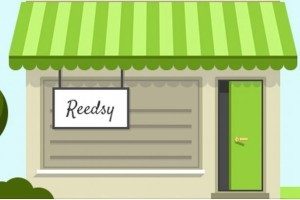
When starting Reedsy, our ambition was not only to connect authors with vetted, hand-picked editors, designers and marketers. As I wrote when I first introduced Reedsy on Elizabeth’s blog, “we are a technology company at heart”. We wanted to be more than a simple marketplace, we wanted to reinvent the way authors and editors work together – let’s face it, Word wasn’t made for writing books.
That’s why we’ve spent the past several months now on something that we like to call the Reedsy Book Editor. I offered a demo of the tool at the NINC conference last year, and now we are ready to make it live.
There are several concepts that went into building this tool. The first one lies in its design and user experience. There are countless text editors out there, some more beautiful than others, but in the end they all get the job done, and preferences are just a matter of taste.
In our case, our preference lies in simple, minimalistic design. Our product and design team took most of its inspiration from the blogging/publishing platform Medium – with whom I imagine most of you are familiar. We wanted to replicate the same intuitive experience Medium offers to bloggers and adapt it to a much more complex format: books.
You can read more about the design process we went through and the technologies we used here, but I’ll get to the point you’re probably waiting for: the features.
Writing in a beautiful interface – ok, we covered this already.
Painless formatting and export to ePub: our Book Editor respects the layout of an ebook. Therefore, you literally have no formatting to do: the table of contents, copyright page, chapter breaks and other subtleties are inserted automatically.
Automatic typesetting: that’s where it gets really powerful. You can choose between two print templates and export a professionally-typeset, print-ready PDF file.
Not really a feature per se, but worth mentioning: it’s 100% free.
What does this mean? You can write your book, or copy-paste it, into the Reedsy Book Editor and export an ePub and a print file, for free, in a matter of seconds. We have tested our ePub file on all devices and on Amazon’s mobi converter (which means you can get a .mobi file as well from it). And we have been working with IngramSpark to make sure the print-ready file complies with all their guidelines – and it does. Here is an example of what you can do in a few seconds with the Reedsy Book Editor; click on the image to download an excerpt from Michael Doane’s book, The Crossing.
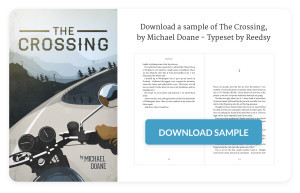
In a nutshell, this means you don’t have to learn how to format or typeset anymore, nor hire someone to do it for you – unless, of course, you want a customized print product. As our designer likes to say: “machines can’t do art yet!”.
This is only the first version of the editor. If you were in the room listening at NINC, you might recall me announcing many more features, like collaborative writing, track-changes, comments, timelines, etc. These are coming, along with a wider selection of templates for the PDF, and you can get a glimpse of what they will look like here.
In the meantime, if you want to test the Reedsy Book Editor, just sign up to Reedsy, create a book, and start writing.
Ricardo Fayet is a co-founder of Reedsy . An avid reader and startup enthusiast, he likes to imagine how small players will build the future of publishing. He also blogs about book marketing on the Reedsy blog.
Reedsy offers a free book formatting tool for writers:
Click To Tweet
The post Introducing the Reedsy Book Editor appeared first on Elizabeth Spann Craig.
February 14, 2016
Apple Makes it Easier to be an Affiliate
by Elizabeth S. Craig, @elizabethscraig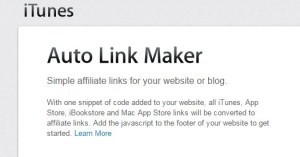
Although I don’t make a fortune as an affiliate with Amazon and Apple, so far it’s proven to be reliable income. And it’s fairly passive income.
The only problem is that it’s something of a hassle. You run your links through the retailer’s affiliate URL link-maker, it assigns your affiliate code for credit, and then if someone clicks on your link, you make a commission from whatever they buy on the site during that shopping session. I do keep my affiliate links in a document so that I can just copy/paste them without having to run through the link-maker again, but it’s still a bit of a time suck. We also have to be careful to follow the retailers’ terms and conditions for use and be sure to put a disclosure on our site when we use these links.
Apple doesn’t ordinarily make my business dealings with them easy. I’m definitely not an Apple fan girl. I find their site difficult to use as an author and am dismayed at the number of readers who have written me telling me they’ve had a hard time locating my books on their site. This spurred me to change my website, create dedicated pages for each of my books, and include a direct link to Apple. I also find Apple the most difficult retailer to upload to. And their royalty reporting reminds me of the reports I get from trad-publishers–inscrutable.
However! A pleasant surprise from Apple recently. I discovered that we can embed code in our blog/site’s footer section to have all Apple links automatically convert to Apple Affiliate links.
The link-maker is here: https://autolinkmaker.itunes.apple.com/ . And a detailed walk-through of how to add the code in our footer for WordPress, Blogger, and Tumblr is here.
Another cool thing Apple has that Amazon doesn’t offer is the ability to attach a geo-prefix to our links so that readers are automatically redirected to their country’s Apple retail site. With Amazon, we have to go through a 3rd-party to have our links automatically open in the correct country (and the 3rd party services I’ve looked into charge a commission).
The service was briefly explained in my Apple Affiliate newsletter that I recently received (I’m starting to benefit from the fact that I’m now opening these newsletters):
“Affiliate Tip
Ensure your link works globally by adding a geo prefix to the beginning of your link as shown in the example below. You can add this geo prefix manually to your links, or it will be added automatically when you use Link Maker. Having links geo ready ensures links work globally; this is especially important for music where songs and albums may have different iTunes URLs by geo.
Example link: https://geo.itunes.apple.com/us/album/25/id1051394208?app=music&at=1010laH6 ”
My question is….can we get this cool geo feature to work with the auto-link-maker? I haven’t fiddled around with it to see, but it would certainly be convenient.
Have you checked into being an affiliate for your retailers? Any cool tips to share?
Apple's tool automatically changes Apple links to Apple Affiliate Links:
Click To Tweet
The post Apple Makes it Easier to be an Affiliate appeared first on Elizabeth Spann Craig.
February 13, 2016
Twitterific Writing Links
by Elizabeth S. Craig, @elizabethscraig
Twitterific writing links are fed into the Writer’s Knowledge Base search engine (developed by writer and software engineer Mike Fleming) which has over 30,000 free articles on writing related topics. It’s the search engine for writers.
(developed by writer and software engineer Mike Fleming) which has over 30,000 free articles on writing related topics. It’s the search engine for writers.
Happy Valentine’s Day!
Supporting Characters: Allies: http://ow.ly/XLEP8 @JadenTerrell @KillerNashville
Improve Your Writing Platform (or Author Platform) in 30 Days: http://ow.ly/XLEWU @robertleebrewer
“Familiarize with” and “Habituate to”: http://ow.ly/XLEYq @MaeveMaddox
Scrivener Tips And Turning Failure Into Entrepreneurial Success: http://ow.ly/XMIAg @ScrivenerCoach @thecreativepenn
Considering the Irrationality of Your Characters: http://ow.ly/XLF9c @SeptCFawkes
10 Tips to Writing from Multiple POVs: http://ow.ly/XNqdo @aimiekrunyan
The Ultimate Pilot Story Checklist: Transparent: http://ow.ly/XNqqD @cockeyedcaravan
Big Picture Story Structure: 3-Act Structure: http://ow.ly/XMV4t by John Wong @mythicscribes
A Handy-Dandy Do-Over Tip: http://ow.ly/XNqVA @writingtracy
You’re Not Alone: Creativity and Depression” http://ow.ly/YhJXj @BlueSunDeb
16 Self-publishing Predictions: http://ow.ly/XIJ0C @DebbieYoungBN
5 Reasons Writers Need Google Plus, Even Though New Google Plus is Awful: http://ow.ly/YhJTw @annerallen
Shepherding a Self-Published Picture Book to Success: http://ow.ly/XGF3T @sangeeta_editor @bbowen949
36 Plot Ideas for your Novel: http://ow.ly/XLFaW @JillWilliamson
Teaching Writing: Making Structure Visible: http://ow.ly/XLFfX @Betsy_writes
“Confused With” and “Confused About”: http://ow.ly/XLF5m @MaeveMaddox
Most Common Mistakes: Ineffective Setting Descriptions: http://ow.ly/XLF6H @KMWeiland
Fiction Writing Checklist: http://ow.ly/XLFe7 @AJ Humpage
Public speaking for indie authors: http://ow.ly/XIIkd @denisebarnesuk
Goodbye Shelfari, Hello Goodreads: http://ow.ly/XIIB0 @LynneCantwell
10 Ways to Generate Story Ideas: http://ow.ly/XIIRK by Chris Winkle @mythcreants
A Room of One’s Own: the Place in One’s Head: http://ow.ly/XIIWU @jaqhazell @womenwriters
What Writers Can Learn from Failed New Year’s Resolutions: http://ow.ly/XIIGi @rosannebane
Using Kindle Scout as Part of a Book Launch Campaign: http://ow.ly/XGEWx @kb_jensen
Don’t put off writing: who knows what tomorrow brings? : http://ow.ly/XIITH @mdilloway
How to Create an Advance Information (AI) Sheet: http://ow.ly/XIIhl @DebbieYoungBN
Time-Saving Social Media Tip for Writers: http://ow.ly/XIIHF @sararosett
Turning a bad critique into a positive experience: http://ow.ly/XIIZ7 @BetterScribe
7 Tips for Writing About Other Cultures: http://ow.ly/XIINE @kathryntanquary
When to Use the Present Tense: http://ow.ly/XIIDV @ceciliaedits
8 Strategies for Marketing Your Self-Published Book: http://ow.ly/XIIQg @CSLakin
Tips for outlining: http://ow.ly/XIIL6 @AmberSkyeF
How to Start a Novel: A Checklist for Editing Chapter 1: http://ow.ly/XFKKu @annerallen
Writing Practice Scenes for Character Development: http://ow.ly/XFKrF @lindasclare
The Paid Reviews Debate: http://ow.ly/YaRQN @Porter_Anderson @JaneFriedman
Don’t Worry, It Only Gets Harder: http://ow.ly/XFJy1 @DanBlank
5 Things 1 Author Wishes She’d Known Before Publishing Her 1st Novel: http://ow.ly/XFJkR @MirandaBW
Why Outlining Your Scenes Will Help You Write a Great Novel: http://ow.ly/XFJ8l @CSLakin
Setup and Payoff: 2 Equally Important Halves of Story Foreshadowing: http://ow.ly/XFJbK @KMWeiland
Self Publishing as a Lemonade Stand: http://ow.ly/XFJKc @jamesscottbell
Breaking Writing Rules Right: Show Elizabeth S Craig
Accounting 101 for Authors: Types of Businesses: http://ow.ly/XFJE0 @LongValleyPress
The Key Differences Between Middle Grade vs Young Adult: http://ow.ly/XFIZ5 @marielamba
Walking Away From an Unfinished Novel: http://ow.ly/XFJ5y @AuthorLBrown
What Happens When One POV is Better? http://ow.ly/XFJgW @Janice_Hardy
‘A Hybrid World’ of Publishing. Harper Collins on Print in a Digital World: http://ow.ly/YaSZt @Porter_Anderson @pubperspectives
Writers and other artists: 4 ways to take a compliment: http://ow.ly/YaSeN @gigirosenberg
What Does the New @AuthorEarnings Report Say to the Industry? http://ow.ly/YaRjG @Porter_Anderson
Writing and the Creative Life: “Get a mentor”: http://ow.ly/XD4xJ @gointothestory
The Hot Sheet: industry newsletter for authors (30 day free trial): from @Porter_Anderson & @JaneFriedman: http://ow.ly/YaR09”
#Marketing: Finding 1,000 True Fans: http://ow.ly/XD4MY @JeriWB
12 Easy Ways To Boost Attendance At Your Book Signing: http://ow.ly/XD5h1 by Self Publishing Relief
Micro-newsletters: http://ow.ly/XD59P @Janet_Reid
How to promote a book without using social media: http://ow.ly/XD4Hh @sandrabeckwith
3 Typefaces for Books: http://ow.ly/XD5dU @JFBookman
Writer Dilemma: Private Life vs. Public Figures: http://ow.ly/XD4JT @jamigold
How to Set Up Your Goodreads Author Dashboard: http://ow.ly/XD87Y @CaballoFrances
Spark Inspiration and Ignite Creativity: Mindful Concentration on Your Place in Space: http://ow.ly/XD4B8 @jthomasross
Author Newsletters: 6 Tips for Smart Strategies: http://ow.ly/XD85Z @jamigold
Is the weather a major character in your stories? http://ow.ly/XAvzH @calebpirtle
How Writers Can Craft an Effective Setting: http://ow.ly/Y7l6b @MaryBuckham
Convention Basics: 5 Tips to Make Your Book Stand Out http://ow.ly/XAvRM @AP_Fuchs
10 Tips for Kickstarting Your Writing: http://ow.ly/XAv86 @Joannechocolat
How to Create a Professional Press Kit in 8 Easy Steps: http://ow.ly/XAvKS by Jamie Jo Hoang
7 Tips for Creating an Antihero that Readers Will Love: http://ow.ly/XAvbk by Stephanie Norman
A 5-Minute Guide to Evernote: http://ow.ly/XAw0e @ckmacleodwriter
The First 3 Things You Need in Your Scene: http://ow.ly/XAvwj @CSLakin
How To Write A Story With A Great Open Ending: http://ow.ly/XAvta @kerrycreas
On Writers, Hoarders, and Their Clutter: http://ow.ly/XAvCM @barryyourgrau @thelithub
Creating Characters Who Live Off the Page: http://ow.ly/XAw6A by Joseph Gartrell
20-Minute Macro Course: http://ow.ly/XAvXf @ckmacleodwriter
5 Ways to Create an Em Dash: http://ow.ly/XAw2a @ckmacleodwriter
Publishing Could Be Causing a Writing Block: http://ow.ly/XAw3K by Margo Dill
Goodreads: Housekeeping and Book Stats: http://ow.ly/Y4vTY
Crime fiction: when characters say too much, it can get them in trouble: http://ow.ly/Y4nlB @mkinberg
How to be more creative with help from neuroscience and Margaret Atwood : http://ow.ly/XxsGp @KirstenFogg
How to Use Periscope to Build Your Writing Brand: http://ow.ly/XxsDV @WillieshaMorris
Nonfic social media experiment combines Instagram and essays: http://ow.ly/Xxt1o @vqreview
How Blogging Connects Authors with their Target Readers: http://ow.ly/XxrS2 @VoicetoStory
Just Add Tension: How to Make Any Book Better: http://ow.ly/XxsUH @aprilhenrybooks
How a Writer Stays Committed With No Promise of Success: http://ow.ly/Xxsn2 @LisaRomeo by Sandra Hurtes
3 Things You Should Be Writing About On Your Author Blog: http://ow.ly/XxsuB @standoutbooks
Writing Fantasy Fiction: How to Make the Magic Work: http://ow.ly/XxsxH @standoutbooks
What Not to Say in Your Cover Letter to a Literary Journal (or any media venue, ever): http://ow.ly/Xxsrz @LisaRomeo
How to Take a Break from Blogging (Without Looking Flakey): http://ow.ly/XxrWm @BrooksEditorial
How the ellipsis arrived in English literature: http://ow.ly/Xxszn @alisonflood @guardianbooks
Good Marketing vs. A Good Pitch: http://ow.ly/XxsNe @LaurieAshbourne
Does Your Saboteur Push You into Writer’s Block? http://ow.ly/XxrnB @rosannebane
The best writing links of the week on Twitterific:
Click To Tweet
The post Twitterific Writing Links appeared first on Elizabeth Spann Craig.
February 11, 2016
Problems with Multitasking
by Elizabeth S. Craig, @elizabethscraig
We had a winter storm in North Carolina a couple of weeks ago. Winter storms in NC are a big deal. There are a few reasons for that. For one, everything shuts down…there’s no school, no businesses open, and no one at work. Since these are rare occurrences in the Charlotte area, there’s not much in the budget for clearing the streets. So…the stuff sticks around until it melts. The problem is that it gets warm enough during the days (45-50 degree F) to melt and then goes back below freezing at night and refreezes the stuff. Then everyone slips all over the road on black ice.
My husband called me on his way home from work right before the storm hit and asked if we needed anything. I said no, that I’d run a slew of errands all day and we were fine.
My teenaged daughter was listening to our phone conversation. “Why is Dad even asking? Doesn’t he know it’s you? You’re always prepared.”
It’s true that I’m a bit of a Girl Scout. But then, I was a Girl Scout.
My daughter added something else. “You’re so organized that you’re disorganized.”
I had to think about that one for a minute. But then I realized that she was right. I have a tendency to get into a frenetic pace and hop from one task to another, remembering something that needs urgent (or seemingly needs urgent) attention right when I’m in the middle of another task.
It’s multitasking. And, while I can multitask anything if vacuuming is one of the tasks, when it comes to things that require careful thought, I need more focus. What’s more, multitasking makes me stressed out and generally unpleasant to be around. I’ve also learned that, for me, multitasking usually isn’t as effective as focusing on and knocking out a single task.
Apps and Smart Calendar Use Help Avoid Multitasking
Calendar:
What’s helping is my attempt to prioritize tasks and my (new) understanding that I need to assign some tasks farther into the future. For example, I saw a cool article by CS Lakin on Jane Friedman’s blog and decided, “Yeah, this is really important. Have they changed the book description “show more” that much?” And I dropped everything and started working on it. But I didn’t NEED to. Everything isn’t an emergency. I need to slow down this fast pace I’m setting.
This time, instead of multitasking or dropping one task to pick up another, I put it on my calendar to review on a future day.
The main tool that I use for keeping things on schedule is Google Calendar. It’s free and, since I have it on my phone, I always have it with me. I particularly like the “week” view on the calendar. When I see an opening, I click on the day to create an event, and then type in whatever task I need to take care of. This makes me feel relieved immediately–that I don’t have to remember the task, and that I’m on my way to addressing it.
Apps:
Another tool that I use for both general organization and my blog editorial calendar is One Note (which came included with my Microsoft Office bundle, but you can also download it…it’s free). Sometimes when I’m doing business-related work or working on my book, I will get ideas for things that I want to share on my blog. That’s when I add the post idea to a page in my Blog Notebook on One Note (One Note is set up with a notebook and page structure. Although I like Evernote and use it for a lot of different things, for some reason the way you have to do “stacks” on Evernote doesn’t work as well for me as the old notebook/page system in One Note.
A new app that I’m using is Remember the Milk. It’s free and integrates with online calendars like iCal and Google Calendar. You add tasks to be completed and a reminder will be emailed to you. The tasks will also show up in the sidebar of your calendar. I like the app and I’ve been using it for the past few weeks. But I’m not sure it adds any additional functionality to my original system of adding tasks as events on Google Calendar. I guess the lesson there is…if it ain’t broke, don’t fix it. But if you don’t have an established method of handling tasks, I think this is a great tool to try.
Another free app/site I’m using is 135 List. It helps me prioritize my tasks each day. So far it’s been a useful additional tool to supplement what I’ve already been doing. And it helps me remember what’s most important to complete instead of my scrambling around thinking everything is an emergency.
So now I’m not so organized that I’m disorganized. :) How do you keep your tasks straight and keep from getting overwhelmed with your workload?
Apps can help us avoid problematic multitasking:
Click To Tweet
Image: MorgueFile: Seemann
The post Problems with Multitasking appeared first on Elizabeth Spann Craig.
February 7, 2016
Goodreads Housekeeping and Book Stats
by Elizabeth S. Craig, @elizabethscraig
Goodreads is a popular way for readers to discover new authors and talk about books. As a reader, I’ve found some excellent recommendations there. I frequently hear my friends talk about the site. And, when I was speaking once at a school, a teacher came up to me afterward and said, “I looked you up while you were speaking. You’re even on Goodreads!”
As a writer, I usually avoid Goodreads as much as possible. It’s sometimes not a warm and friendly environment for authors. But then…it’s for readers.
My usual tactic in dealing with Goodreads is to avoid logging in until I get a message on the site. However! This site is important enough for us that we need to do general upkeep and housekeeping there. And there are some cool features to tempt us in.
Things to check on and update on Goodreads:
Is our series description effective? Is it the same description that we have listed on our website and retail sites (consistency with metadata can be important for SEO, etc.)
Are all of our books listed under our name?
Are previews enabled on all of our books on Goodreads? If not, we’ll want to fix that. The previews should be right below our books, as they are on Amazon.
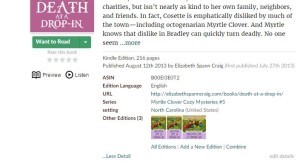
If we’ve changed covers, have updated editions of our book, have we set the book we want as the primary edition?
If we go into our individual book pages on the site, have we included as much metadata as possible? Who is listed as our publisher?
What’s listed as the official URL of the book (current practice is to have a page for each book on our website. I’ve listed my site’s book page as the official URL).
What’s the book’s setting? Who knows, maybe there are readers specifically looking for stories set in a particular location? Maybe local press may search for authors who write local settings.
Before saving/sending the changes, I made a short note (as one of the site’s “librarians”) saying I was just adding more information on each book.
Other things we can do on the site:
Remember that we can make updates on both our author profile on the site (pull up one of your books and click on the name, after you’re signed into the site) and through our author dashboard. It might be a good idea to do a quick check to see if any updates are needed on either one.
We can add a Goodreads tag to our Facebook page. This would likely be a smart cross-promo feature.
We can add a Goodreads widget to each individual book page on our website to make it easy for readers to add our books as “to read.”
We can enable Goodreads Author Q&A. I’ve had some really nice interaction with readers that way.
Goodreads giveaways can be an effective way to get awareness for our books (and, hopefully, to generate some reader reviews).
Goodreads seems to be trying to capitalize a bit on the popularity of images. There’s a feature where we can upload pictures (obviously images that aren’t under copyright) that tie into our book…or, I guess, they could be pictures we take of things that inspired us for our book or where we write, etc.
Have a book trailer or an interview on video? Goodreads is a logical place to upload it. You can add it right on your author profile page.
Have you mentioned your newsletter signup link in your bio for Goodreads? This is a good place to do it.
Book Stats:
One cool thing we can do on our author dashboard is see our book stats for Goodreads. You can choose the type of graph you’d like to see. I will say that if you have a lot of books, it can look like a bunch of scribble. If yours looks like scribble (like below), click on “click here for a breakdown” for a list that might make more sense. All I get from the chart below is that people really wanted to read “Body at Bunco” for some reason.
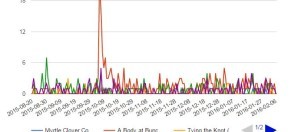
On that stats page, we can also see our total of books added and the total number of unique users adding them. Plus we can see our total of Goodreads reviews. I apparently have 845 reviews on Goodreads. This is another reminder to me that, despite my reluctance to spend time on the site, it’s an important tool, I need to keep my presence there updated.
Are you on Goodreads? Done any updates there lately?
Tips for making the most of our Goodreads profile:
Click To Tweet
The post Goodreads Housekeeping and Book Stats appeared first on Elizabeth Spann Craig.
February 6, 2016
Twitterific Writing Links
by Elizabeth S. Craig, @elizabethscraig
Twitterific writing links are fed into the Writer’s Knowledge Base search engine (developed by writer and software engineer Mike Fleming) which has over 30,000 free articles on writing related topics. It’s the search engine for writers.
(developed by writer and software engineer Mike Fleming) which has over 30,000 free articles on writing related topics. It’s the search engine for writers.
How Writers Can Optimize Their Book’s Description on Amazon: http://ow.ly/XsFpr @CSLakin
Authors United’s Divisive Stand on Amazon: http://ow.ly/XZkoI @Porter_Anderson @pubperspectives
Roundup of the Top #AskBookBub Questions of 2015: http://ow.ly/XsFCT @dianaurban
How to Find Beta Readers to Improve Your Book: http://ow.ly/XsFWy @shesnovel
3 Things That Accelerated 1 Writer’s Author Growth in 2015: http://ow.ly/XsFsp @monicaleonelle
How to Create an Author Brand: 4 Easy Steps: http://ow.ly/XsFME @suzannahwindsor
When is the Right Time to Discount Your Book? http://ow.ly/XsFEG @dianaurban
Goodreads Giveaways: http://ow.ly/XsFy5 @cathryanhoward
Preview Widget: Amazon Book Marketing Tool: http://ow.ly/XsFFV @fictionnotes
How To Consistently Write 3500-–4000 Words Per Hour: http://ow.ly/XsFv8 @monicaleonelle
Problems for the Privileged in Crime Fiction: http://ow.ly/XZkFP @mkinberg
Free Cheat Sheets for Adobe Illustrator, Photoshop, and More: http://ow.ly/XYLrL @firstsiteguide @AnjaSkrba
Subtly Boost Your Dialogue’s Power With Body Language: http://ow.ly/XqXyO @RidethePen
Basic MS Word: When Submitting a MS: http://ow.ly/XuqeT from Interrobangs
26 fantastic no-cost tools for writers: http://ow.ly/Xuqbh @pubcoach
Writing books versus Flash Fiction : http://ow.ly/Xuq1c @ClaireFuller2
How Writers Can Remix the Past: http://ow.ly/XuqHs @drewchial
What Exactly Does An Editor Do? The Role Has Changed Over Time : http://ow.ly/XuqK7 @LynnPNeary @nprnews
Should Published Authors Attend Conferences? http://ow.ly/XuqnJ @rachellegardner
Editing Tips for the Indie Author: http://ow.ly/XuqQf @JoeMoore_writer
5 Ways to Tell if a Subplot is Leading You Astray: http://ow.ly/XuqBP @Janice_Hardy
Dangling Modifiers: http://ow.ly/Xuqs2 @Janice_Hardy
5 Reasons to Write a Short Story: Develop and Market Your Novel: http://ow.ly/XsFHQ @fictionnotes
Dictating a Book? Tips for Editing the First Draft: http://ow.ly/XsFRE @byondpapr
The Search for the Unexpected: the Key to Voice and Plot in Fiction: http://ow.ly/XuqED @MartinaABoone
4 Steps to Creating a Compelling About Page: http://ow.ly/XxrPt @VoicetoStory
Eavesdropping for story ideas and other tips from a veteran novelist: http://ow.ly/Xxrti @WarrenAdler
Amazon’s New Warning Labels: http://ow.ly/XZq6B
Authors Guild: The Fair Contract Initiative: http://ow.ly/XYQfu @victoriastrauss
The Most Obvious Writing Tool You’re Not Using: http://ow.ly/XsFOC @suzannahwindsor
10 #Wattpad Insights to Whet Your Appetite: http://ow.ly/XYL6U @jayartale @OrnaRoss
The e-pub revolution isn’t over (regardless of what you’ve heard) http://ow.ly/XqXre @FuseLiterary @AgentSavant
Writing about Hacking: How To Hack: The Basics: http://ow.ly/XWTCv @SueColetta1
5 Tips For Your Office Desk: http://ow.ly/XpkOr from Feng Shui for Writers
Want to Speak at Writing Conventions? How to Write a Great Pitch: http://ow.ly/XplFO @arinblackwrites
Tips For Balancing Writing and Life: http://ow.ly/XqXoU @susankayequinn
3 Keys to Regain Your Writing Habits: http://ow.ly/XqXny @RuthanneReid
Building Blocks of a Novel: Word Choice: http://ow.ly/XqXDd @JulieEshbaugh
7 Ways to Help You Be Precise in Your Writing: http://ow.ly/XqXJc by Dawn Field
Writers: How Succeed at “Building Platform” Without Really Trying: http://ow.ly/XqXqm @annerallen
Back up your work: http://ow.ly/XqXB4 @MarcyKennedy
Tips for cutting down on word count: http://ow.ly/XqXMv @KBullockAuthor
7 Mistakes You’re Making With Your Author Blog And How To Fix Them: http://ow.ly/XqXue @thecreativepenn
Midpoints: A Breakdown: http://ow.ly/XqXEn @sjaejones
Scene Structure and Character Arc: http://ow.ly/XqXLp @CSLakin
What’s Killing Your Creativity? Probably Not What You Think: http://ow.ly/Xpl3F @emily_tjaden
3 literary translators with tips and secrets: http://ow.ly/XTnaP @Roz_Morris @fwdtranslations @Intralingo @alisonlayland
Beyond Me, Myself, and I: 4 Ideas for Escaping the First-Person Bubble: http://ow.ly/X9LJP @benzbox
The power of the hero’s journey: http://ow.ly/Xphf7 @patverducci
Writing Worksheet: Villains: http://ow.ly/XpgJt @EvaDeverell
1st Pages of Best-Selling Novels: Nicholas Sparks’s “See Me”: http://ow.ly/XplV3 @CSLakin
On Keeping a (Writing) Notebook (or 3): http://ow.ly/XpgOX @brevitymag @RandonNoble
Breaking the Writing Rules: http://ow.ly/Xpm5t @MaryVeeWriter
Mastering the Art of the Cliffhanger Chapter Ending: http://ow.ly/XplQk @rlbelliston
10 Character Cliches To Watch Out For: http://ow.ly/XplnT @NatePhilbrick
A Revision Checklist: http://ow.ly/Xpl9x @kelsieengen
3 fiction marketing mistakes that will hold you back: http://ow.ly/Xplxz @sandrabeckwith
Writing: Tension vs. Energy: http://ow.ly/Xplja @DonMaass
10 Ten Tips to Write When You Don’t Feel Like It: http://ow.ly/Xm6AP @FlynnGrayWriter
Planning out the year: where do you want to be 1 year from now? http://ow.ly/Xm7Em @lisajjackson
BookFunnel: Low-Cost Ebook Giveaway Hosting: http://ow.ly/XH3PG @mollygreene
Motivated by Motifs: http://ow.ly/X9LsM The Daily Post
3 Tools for More Productive and Organized Writing: http://ow.ly/Xm6QV @jenn_mattern
1 Writer’s Rocky Road to Publication: http://ow.ly/Xm71m @CharlieDonlea
A Brief History of Book Illustration: http://ow.ly/Xm7lF by Chris Russell
5 Traps and Tips for Character Development: http://ow.ly/Xm6Xf @LifeRichPub
5 Ways to Maximize Your Morning When You’re Not a Morning Person: http://ow.ly/Xm7K8 @besscozby
4 Personality Types That Will Derail Your Literary Event: http://ow.ly/Xm7gB by Tim Johnson
The Anatomy of a Love Scene: http://ow.ly/Xm6xi @spinellauthor
The Complete Guide to Query Letters: Nonfiction Books: http://ow.ly/Xm6GU @JaneFriedman
9 Ways to Stop Your Novel from Stalling: http://ow.ly/Xm6M7 by Tracey Barnes Priestley
A way to organize blog posts you want to read: http://ow.ly/XjgQZ @cathychall
Drafting in Layers: http://ow.ly/XMSdU
Thriller Writing Competition: free for US and UK authors to enter: cash and editorial assessment prizes: http://ow.ly/XGzyT @ReedsyHQ
Spring Cleaning: Reorganizing Your Blog: http://ow.ly/X9Ly6 The Daily Post
7 Visibility Tips: http://ow.ly/Xjhe0 @DeniseWakeman
4 Post-Its to Put Over Our Desks: http://ow.ly/XjgMS @victoriamixon
How a Writer Turned Her Blog Into A Book : http://ow.ly/Xjh7U @hungrywriting @womenwriters
Considering Self-Publishing? You Might Want to Do This First: http://ow.ly/Xjh5n @chucksambuchino
Tips for our 2nd Draft: http://ow.ly/XjhoO @JessicaPMorrell
How To Make Effective Goals When Facing The Unknown: http://ow.ly/XjhH7 @stephmorrill
Keeping Resolutions 101: How to Relish a Challenge: http://ow.ly/XjhCT @reallucyflint
First Pages of Best-Selling Novels: The Martian: http://ow.ly/Xjhv6 @CSLakin
Do You Need a Literary Agent? The Definitive Pros and Cons List: http://ow.ly/Xjhz4 @ClaireABradshaw
5 Ways to Improve Your Twitter Profile: http://ow.ly/Xjhlf @DeniseWakeman
The links I shared last week: http://ow.ly/XKGRH .All the links I’ve ever shared (30K+, free and searchable): writerskb.com
Make the Most of Repetition in Your Writing: http://ow.ly/X9Ll7 @benzbox
5 Reasons Why You Stopped Writing Last Year: http://ow.ly/Xgsfs @KelsieEngen
7 steps for goal creation and implementation: http://ow.ly/Xgqnt @DIYMFA
5 Brainstorming Techniques for Writers: http://ow.ly/Xgt3d @LindaUKmasters
Why Money Matters in Fantasy: http://ow.ly/XgqjV @EmilyFRussell
Writing a Prologue that Works: http://ow.ly/Xgqln @lindasclare
7 Questions to Help Writers Set Meaningful Goals: http://ow.ly/XgqY6 @colleen_m_story
The best writing links of the week on Twitterific:
Click To Tweet
The post Twitterific Writing Links appeared first on Elizabeth Spann Craig.
February 4, 2016
Follow Up–Amazon Warning Labels
By Elizabeth S. Craig, @elizabethscraig
Once again, I chose to focus on being patient as my New Year’s resolution. By this point, it’s my top recurring resolution of all time.
As I’ve written recently, one interesting thing about being a self-published writer is how quickly we can become accustomed to…indeed, addicted to…control. We have control over everything as a self-published writer, which is both a blessing and a curse.
Actually, however, we don’t have control over everything. One glaring exception is our retailers.
For a week, my addiction to control and my patience were both sorely tested.
As a quick review, I mentioned in my post on January 22 that I had received an email from Amazon about quality control measures they were implementing. The email requested changes to my book file. If the changes weren’t made, the book would get a warning label on its product page at the first of February. My email focused primarily on a formatting issue that needed correction–the file was formatted in 2011 by my previous formatter. The book received an attractive (and very pricey) interior book design. Unfortunately, apparently the formatting doesn’t work well with the current Kindle devices. Some elements apparently don’t show up…including chapter headings, the first letter of each chapter, the dedication…you get the idea. The day I received the email, I made the corrections Amazon asked for, contacted my new formatter, and published a new file to KDP.
Amazon’s initial email implied that my uploaded and corrected file would be automatically reviewed. However, since I’m now apparently something of a control freak, I decided to email Amazon on the 21st and open a ticket on the issue. I’m withholding the names from the Amazon KDP customer service emails.
The timeline went like this:
Jan. 20…received initial quality control email. I fixed all the problems with the help of my formatter and published the updated, corrected version.
Jan. 21…I wrote the KDP customer service team early in the morning to let them know I’d uploaded a corrected file and request a review of the book so that Amazon could note it was in compliance.
Jan. 21…from Amazon: Thanks for letting us know you’ve republished an updated version of your book. I’ve forwarded your information to our Quality team for follow-up. Our quality team will review your file. You should hear back from them in the next 1-2 business days. Thanks for your continued patience.
Jan. 29…I follow up with another email, concerned I was getting close to Feb. 1 and I hadn’t heard back from Amazon regarding a review.
Jan. 29…Email from Amazon again requesting the (same) corrections that I’d already made and stated on the 21st that I’d made. And this: “Sorry for any delays in this review process and notification.”
Jan. 29…I wrote back (a bit panicky now): “Hi, All of the issues have been corrected over a week ago. Please have the review team confirm.
Jan. 30: From Amazon: “Hello, We’ll need a little time to look into this. We’ll contact you with more information by the end of the day on Tuesday, February 2. Thanks for your patience.”
Feb. 1: From Amazon: Thank you for resubmitting your content to us! We have reviewed the new content, but several serious new issues are now present in your book and we have had to block your book from sale. (Following that was a list of the same requested corrections that I had fixed on the 20th and stated on the 21st that I’d fixed).
So, Monday was a Code Red day. That was the day there was a warning label on one of my most popular books–a book that’s been available since 2011. As you can see below (sorry, couldn’t get it any larger without getting blurry, but you get the gist of it), I did get one of the dreaded warning label (“item under review”). Worse, the book was removed from sale (“book is currently unavailable”). I wrote several emails back to Amazon. These emails all still contained the words “please” and “thank you,” (I am Southern, after all), but there may have been excessive use of exclamation points on my part. :) I included screenshots of the text locations in question, showing there were no remaining issues.

I mentioned that the book was one of a series. And that various readers had informed me that the first book in that series had been featured by Amazon a week earlier as one of the KDP Daily Deals for their mystery readers (bad timing for me). I mentioned that the book that was removed from sale has quite a few reviews and is the free book I give to readers for subscribing to my newsletter.
The only good thing was that at some point in this process, KDP opened up phone support to me. At least, this is what a representative stated in an email. However, I’m wondering if maybe we can receive phone support all the time. Amazon linked me to a site where I could request a call-back “in five minutes.” Here’s the page: https://kdp.amazon.com/contact-us . Their hours are 6:00 a.m. to 5:00 p.m. Pacific time, Monday through Friday. They called right in that 5-minute window and I explained the timeline and the fact that everything had been corrected 10 or 11 days earlier.
The customer service rep accessed the book and verified on the phone that all requested changes had been made. She sounded baffled and stated that she couldn’t understand why, when it only took a couple of minutes to check, the book had been flagged with the label.
I didn’t say, although I suspected, that the reason it had been flagged is because a real human being hadn’t verified my corrections.
The rep said that she’d note that all corrections had been made and verified by her, and that she’d forward the request/ticket over to the quality control department.
I assumed this might go into the same black hole as earlier, but my fears weren’t justified.
Although I never got notification that the warning label had been removed, my frequent (obsessive?) refreshing of the book’s product page finally indicated that the label was removed on Tuesday, Feb. 2.
However, once it was removed, I received another email from Amazon:
Feb. 2: (from Amazon): Hello, I wanted to let you know that I’m still working on this with the concerned team. It’s taking longer than usual to resolve this, and I’m very sorry about the delay. I’ll be in touch with you again with an update as soon as possible. Thanks for your continued patience. Regards, (name withheld).
My takeaways from this (besides that we all should keep a very close eye on our inboxes and spam filters for emails from Amazon):
Immediately address the requested corrections. Even though I did immediately address the issues, I still ran into a problem. But if I hadn’t immediately addressed them, it would have been much worse.
Immediately, even though the Amazon email doesn’t specify this, let Amazon know that you’ve made the corrections. This opens up a support ticket. I did immediately let Amazon know, but I still ran into a problem. Again, if I hadn’t let them know, it would have probably taken even longer to resolve.
Amazon is very good on promptly returning emails….same day.
However, Amazon may not actually have human screeners looking for the mistakes. Or, perhaps, the human screeners are overwhelmed.
Keep following up. Escalate. I should never have waited until the 29th to follow-up. This was my main error.
If they open up phone support to you (or if it’s open all the time), give Amazon a call immediately. This is your best shot at getting the problem taken care of.
This is, with any luck at all, my last follow-up on this. I’m not going to lie, this stressed me out in a way that was far out of proportion to the scope of the problem. But when you feel helpless and frustrated and your book has a warning label and is removed from sale? There’s a bit of stress involved. I’ve got 19 books out and I can only imagine the kind of stress I’d feel if I had only one. And, despite the many thanks from Amazon for my continued patience…I apparently still have a lot to work on in the resolution department.
Amazon Warning Labels on Books Under Review:
Click To Tweet
The post Follow Up–Amazon Warning Labels appeared first on Elizabeth Spann Craig.

